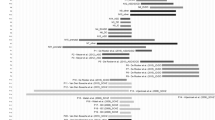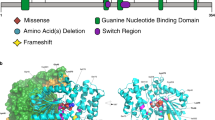Abstract
We report the identification of a recurrent, 520-kb 16p12.1 microdeletion associated with childhood developmental delay. The microdeletion was detected in 20 of 11,873 cases compared with 2 of 8,540 controls (P = 0.0009, OR = 7.2) and replicated in a second series of 22 of 9,254 cases compared with 6 of 6,299 controls (P = 0.028, OR = 2.5). Most deletions were inherited, with carrier parents likely to manifest neuropsychiatric phenotypes compared to non-carrier parents (P = 0.037, OR = 6). Probands were more likely to carry an additional large copy-number variant when compared to matched controls (10 of 42 cases, P = 5.7 × 10−5, OR = 6.6). The clinical features of individuals with two mutations were distinct from and/or more severe than those of individuals carrying only the co-occurring mutation. Our data support a two-hit model in which the 16p12.1 microdeletion both predisposes to neuropsychiatric phenotypes as a single event and exacerbates neurodevelopmental phenotypes in association with other large deletions or duplications. Analysis of other microdeletions with variable expressivity indicates that this two-hit model might be more generally applicable to neuropsychiatric disease.
This is a preview of subscription content, access via your institution
Access options
Subscribe to this journal
Receive 12 print issues and online access
$209.00 per year
only $17.42 per issue
Buy this article
- Purchase on Springer Link
- Instant access to full article PDF
Prices may be subject to local taxes which are calculated during checkout




Similar content being viewed by others
References
Lupski, J.R. Genomic disorders: structural features of the genome can lead to DNA rearrangements and human disease traits. Trends Genet. 14, 417–422 (1998).
Marques-Bonet, T., Girirajan, S. & Eichler, E.E. The origins and impact of primate segmental duplications. Trends Genet. 25, 443–454 (2009).
Mefford, H.C. & Eichler, E.E. Duplication hotspots, rare genomic disorders, and common disease. Curr. Opin. Genet. Dev. 19, 196–204 (2009).
Zhang, F., Gu, W., Hurles, M.E. & Lupski, J.R. Copy number variation in human health, disease, and evolution. Annu. Rev. Genomics Hum. Genet. 10, 451–481 (2009).
Eichler, E.E. et al. Divergent origins and concerted expansion of two segmental duplications on chromosome 16. J. Hered. 92, 462–468 (2001).
Johnson, M.E. et al. Recurrent duplication-driven transposition of DNA during hominoid evolution. Proc. Natl. Acad. Sci. USA 103, 17626–17631 (2006).
Johnson, M.E. et al. Positive selection of a gene family during the emergence of humans and African apes. Nature 413, 514–519 (2001).
Loftus, B.J. et al. Genome duplications and other features in 12 Mb of DNA sequence from human chromosome 16p and 16q. Genomics 60, 295–308 (1999).
Kumar, R.A. et al. Recurrent 16p11.2 microdeletions in autism. Hum. Mol. Genet. 17, 628–638 (2008).
Weiss, L.A. et al. Association between microdeletion and microduplication at 16p11.2 and autism. N. Engl. J. Med. 358, 667–675 (2008).
Ballif, B.C. et al. Discovery of a previously unrecognized microdeletion syndrome of 16p11.2-p12.2. Nat. Genet. 39, 1071–1073 (2007).
Hannes, F.D. et al. Recurrent reciprocal deletions and duplications of 16p13.11: the deletion is a risk factor for MR/MCA while the duplication may be a rare benign variant. J. Med. Genet. 46, 223–232 (2009).
Mefford, H.C. et al. A method for rapid, targeted CNV genotyping identifies rare variants associated with neurocognitive disease. Genome Res. 19, 1579–1585 (2009).
Ullmann, R. et al. Array CGH identifies reciprocal 16p13.1 duplications and deletions that predispose to autism and/or mental retardation. Hum. Mutat. 28, 674–682 (2007).
Itsara, A. et al. Population analysis of large copy number variants and hotspots of human genetic disease. Am. J. Hum. Genet. 84, 148–161 (2009).
McCarroll, S.A. et al. Integrated detection and population-genetic analysis of SNPs and copy number variation. Nat. Genet. 40, 1166–1174 (2008).
Kidd, J.M. et al. Mapping and sequencing of structural variation from eight human genomes. Nature 453, 56–64 (2008).
Zody, M.C. et al. Evolutionary toggling of the MAPT 17q21.31 inversion region. Nat. Genet. 40, 1076–1083 (2008).
Firth, H.V. et al. DECIPHER: Database of Chromosomal Imbalance and Phenotype in Humans Using Ensembl Resources. Am. J. Hum. Genet. 84, 524–533 (2009).
Feenstra, I. et al. European Cytogeneticists Association Register of Unbalanced Chromosome Aberrations (ECARUCA); an online database for rare chromosome abnormalities. Eur. J. Med. Genet. 49, 279–291 (2006).
Phelan, M.C. et al. 22q13 deletion syndrome. Am. J. Med. Genet. 101, 91–99 (2001).
Durand, C.M. et al. Mutations in the gene encoding the synaptic scaffolding protein SHANK3 are associated with autism spectrum disorders. Nat. Genet. 39, 25–27 (2007).
Lindgren, V., Bryke, C.R., Ozcelik, T., Yang-Feng, T.L. & Francke, U. Phenotypic, cytogenetic, and molecular studies of three patients with constitutional deletions of chromosome 5 in the region of the gene for familial adenomatous polyposis. Am. J. Hum. Genet. 50, 988–997 (1992).
Mao, X. et al. Genetic alterations in primary cutaneous CD30+ anaplastic large cell lymphoma. Genes Chromosom. Cancer 37, 176–185 (2003).
Roberts, A. et al. The cardiofaciocutaneous syndrome. J. Med. Genet. 43, 833–842 (2006).
Xu, B. et al. Strong association of de novo copy number mutations with sporadic schizophrenia. Nat. Genet. 40, 880–885 (2008).
Helbig, I. et al. 15q13.3 microdeletions increase risk of idiopathic generalized epilepsy. Nat. Genet. 41, 160–162 (2009).
Sharp, A.J. et al. A recurrent 15q13.3 microdeletion syndrome associated with mental retardation and seizures. Nat. Genet. 40, 322–328 (2008).
Stefansson, H. et al. Large recurrent microdeletions associated with schizophrenia. Nature 455, 232–236 (2008).
Turner, T.H. Schizophrenia and mental handicap: an historical review, with implications for further research. Psychol. Med. 19, 301–314 (1989).
Moorhead, T.W. et al. Voxel-based morphometry of comorbid schizophrenia and learning disability: analyses in normalized and native spaces using parametric and nonparametric statistical methods. Neuroimage 22, 188–202 (2004).
Sanderson, T.L., Best, J.J., Doody, G.A., Owens, D.G. & Johnstone, E.C. Neuroanatomy of comorbid schizophrenia and learning disability: a controlled study. Lancet 354, 1867–1871 (1999).
Fombonne, E. Epidemiological trends in rates of autism. Mol. Psychiatry 7 Suppl 2, S4–S6 (2002).
Woodberry, K.A., Giuliano, A.J. & Seidman, L.J. Premorbid IQ in schizophrenia: a meta-analytic review. Am. J. Psychiatry 165, 579–587 (2008).
International Schizophrenia Consortium. Rare chromosomal deletions and duplications increase risk of schizophrenia. Nature 455, 237–241 (2008).
Mefford, H.C. et al. Recurrent rearrangements of chromosome 1q21.1 and variable pediatric phenotypes. N. Engl. J. Med. 359, 1685–1699 (2008).
Bassett, A.S., Marshall, C.R., Lionel, A.C., Chow, E.W. & Scherer, S.W. Copy number variations and risk for schizophrenia in 22q11.2 deletion syndrome. Hum. Mol. Genet. 17, 4045–4053 (2008).
DeLisi, L.E. et al. Clinical characteristics of schizophrenia in multiply affected Spanish origin families from Costa Rica. Psychiatr. Genet. 11, 145–152 (2001).
DeLisi, L.E. et al. Genome-wide scan for linkage to schizophrenia in a Spanish-origin cohort from Costa Rica. Am. J. Med. Genet. 114, 497–508 (2002).
Manolio, T.A. et al. New models of collaboration in genome-wide association studies: the Genetic Association Information Network. Nat. Genet 39, 1045–1051 (2007).
Wellcome Trust Case Control Consortium. Genome-wide association study of 14,000 cases of seven common diseases and 3,000 shared controls. Nature 447, 661–678 (2007).
Kirov, G. et al. Support for the involvement of large copy number variants in the pathogenesis of schizophrenia. Hum. Mol. Genet. 18, 1497–1503 (2009).
Shaikh, T.H. et al. High-resolution mapping and analysis of copy number variations in the human genome: a data resource for clinical and research applications. Genome Res. 19, 1682–1690 (2009).
Bejjani, B.A. et al. Use of targeted array-based CGH for the clinical diagnosis of chromosomal imbalance: is less more? Am. J. Med. Genet. A. 134, 259–267 (2005).
Selzer, R.R. et al. Analysis of chromosome breakpoints in neuroblastoma at sub-kilobase resolution using fine-tiling oligonucleotide array CGH. Genes Chromosom. Cancer 44, 305–319 (2005).
Sebat, J. et al. Strong association of de novo copy number mutations with autism. Science 316, 445–449 (2007).
Acknowledgements
We thank the subjects and their families for participating in this study. We thank M. Whyte for providing cardiological evaluation (for case SG07). We thank A. Singleton, L. Ferrucci and R. Krauss for sharing the control CNV data generated with support from the Intramural Research Program of the National Institute on Aging, National Heart, Lung, and Blood Institute (PARC project), and the National Institutes of Health, Department of Health and Human Services. For the schizophrenia study, genotyping of samples was also provided through the genetic association information network (GAIN). Samples and associated phenotype data for the genome-wide association of schizophrenia study were provided by the Molecular Genetics of Schizophrenia Collaboration (principal investigator: P.V. Gejman, Evanston Northwestern Healthcare (ENH) and Northwestern University, Evanston, Illinois, USA). We also thank J. Smith for SNP genotyping; T. Louie for bioinformatics support; C. Campbell, L. Perez-Jurado, G. Kirov, M.K. Rudd and C. Lese-Martin for useful discussions; and T. Brown, P. Sudmant and J. Kitzman for critical review of the manuscript. This work was supported by NIH grant HD065285 (E.E.E.), a grant from the Simons Foundation (SFARI 137578 to E.E.E.) and a NARSAD Award (M.-C.K.). G.M.C. is supported by a Merck, Jane Coffin Childs Memorial Fund post-doctoral fellowship. E.E.E. is an investigator of the Howard Hughes Medical Institute.
Author information
Authors and Affiliations
Contributions
This study was designed by S.G., L.G.S. and E.E.E. J.A.R., B.C.B. and L.G.S. supervised array-CGH experiments at Signature Genomics. J.A.R. coordinated clinical data collection. T.W., S.E.M., D.E.D., D.L.L., J.S., L.E.D. and M.-C.K. contributed to schizophrenia data collection and analysis. S.G., L.V. and C.B. performed high-density array-CGH experiments. G.M.C. and A.I. analyzed control CNV data. S.G., F.A. and J.M.K. performed genome structure analysis. F.A. performed FISH experiments. S.G. and P.S. sequenced and analyzed candidate genes. S.R.B. and B.L.B. performed haplotype analysis. K.P., D.M.F., G.C.G., J.J.W., A.A., D.D.W., P.R.M., J.D., B.P.G., S.A.E., R.S., V.C.B., W.S., M.T.M., J.J.H., B.N.F., C.H., J.P.J., J.R.O., J.B.M., U.S., L.F.E., D.E.-K., J.L.G., J.K., B.S., Y.L., A.B., D.M.M.-M., E.H.Z., M.A.D., T.H.S., E.H., K.L.F., M.F., C.R. and J.G. provided clinical information. H.C.M. provided 1q21.1 data. S.G., G.M.C., M.-C.K. and E.E.E. contributed to data interpretation. S.G. and E.E.E. wrote the manuscript.
Corresponding author
Ethics declarations
Competing interests
E.E.E. is a member of the Scientific Advisory Board of Pacific Biosciences. J.A.R. and B.C.B. are employees of Signature Genomic Laboratories, LLC. L.G.S. is an employee of, owns shares in and sits on the Members' Board of Signature Genomic Laboratories, LLC.
Supplementary information
Supplementary Text and Figures
Supplementary Figures 1–4, Supplementary Tables 1–9 and Supplementary Note (PDF 2715 kb)
Rights and permissions
About this article
Cite this article
Girirajan, S., Rosenfeld, J., Cooper, G. et al. A recurrent 16p12.1 microdeletion supports a two-hit model for severe developmental delay. Nat Genet 42, 203–209 (2010). https://doi.org/10.1038/ng.534
Received:
Accepted:
Published:
Issue Date:
DOI: https://doi.org/10.1038/ng.534
This article is cited by
-
Clinical findings and genetic analysis of patients with copy number variants involving 17p13.3 using a single nucleotide polymorphism array: a single-center experience
BMC Medical Genomics (2022)
-
Chromosomal microarray analyses from 5778 patients with neurodevelopmental disorders and congenital anomalies in Brazil
Scientific Reports (2022)
-
Copy number variants (CNVs): a powerful tool for iPSC-based modelling of ASD
Molecular Autism (2020)
-
Comprehensive phenotyping of neuropsychiatric traits in a multiplex 3q29 deletion family: a case report
BMC Psychiatry (2020)
-
Implementation of chromosomal microarrays in a cohort of patients with intellectual disability at the Argentinean public health system
Molecular Biology Reports (2020)



